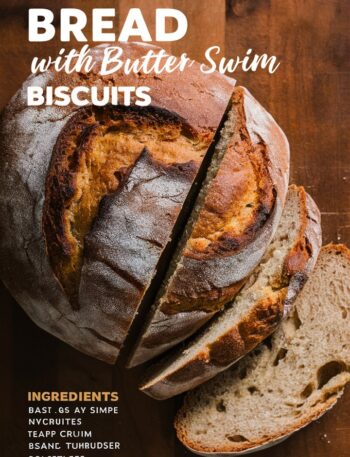Few things in baking feel as magical as watching pita bread puff up in the oven or skillet, transforming from a simple round of dough into a pocket of airy goodness. Unlike most breads, pita isn’t just about taste—it’s about texture, versatility, and tradition. This flatbread, with roots in the Middle East and Mediterranean, has been nourishing families for thousands of years.
If you’ve only ever eaten the packaged versions from the grocery store, you’re in for a revelation. Homemade pita bread is soft, chewy, and fresh, free of preservatives, and it fills your kitchen with the comforting aroma of warm bread. Even better? It requires only a handful of everyday ingredients and a bit of patience.
In this article, you’ll find:
- A foolproof recipe for soft, fluffy pita bread.
- Step-by-step instructions explained in detail.
- Tips for troubleshooting common issues like flat pita or tough texture.
- Creative serving ideas and variations.
- Storage, freezing, and reheating methods to keep your pita fresh.
- A deeper look into pita’s cultural history and nutritional value.
By the end, you’ll not only master pita bread but also learn how to incorporate it into countless meals, from quick wraps to elegant spreads.
What is Pita Bread?
Pita bread is a type of round flatbread traditionally baked at high temperatures so that the steam inside causes it to balloon, leaving a signature pocket in the center. This pocket is what makes pita perfect for stuffing with fillings like grilled meats, falafel, or fresh vegetables.
Pita has a long history in the Middle East, with archaeological evidence suggesting that early flatbreads resembling pita were baked more than 4,000 years ago. Over time, it spread across the Mediterranean, North Africa, and beyond, adapting to local cuisines.
Today, pita comes in two main forms:
- Pocket Pita – Puffy inside, perfect for stuffing.
- Pocketless Pita – Thicker, softer, and ideal for dipping.
No matter the type, pita is universally loved for its ability to pair with a wide range of foods.
Why You’ll Love This Homemade Pita Recipe
- Soft and Fluffy: Unlike store-bought pita, which can be dry, homemade pita stays tender.
- Versatile: Works as a wrap, sandwich base, scoop for dips, or even as a quick pizza crust.
- Beginner-Friendly: Uses simple ingredients and requires no advanced baking equipment.
- Customizable: Make it plain, whole wheat, garlic-flavored, or even herbed.
- Authentic: Closest you can get to traditional pita baked in clay ovens—without leaving your kitchen.
Ingredients for Perfect Pita Bread
The secret to perfect pita is balance. Too much flour and it becomes heavy; too little yeast and it won’t puff. Here’s what you’ll need:
- 3 ½ cups (440 g) all-purpose flour – Provides structure. You can also use bread flour for extra chewiness.
- 1 ½ teaspoons salt – Enhances flavor and strengthens gluten.
- 1 packet (2 ¼ teaspoons) active dry yeast – Makes the dough rise.
- 1 cup (240 ml) warm water (about 110°F/45°C) – Activates the yeast.
- 1 tablespoon olive oil – Adds tenderness and a hint of flavor.
- 1 teaspoon sugar – Feeds the yeast and helps puffing.
Ingredient Substitutions
- Whole Wheat Pita: Replace half the flour with whole wheat flour.
- Gluten-Free Pita: Use a 1:1 gluten-free flour blend (though texture may vary).
- Flavor Variations: Add herbs like oregano or thyme, or garlic powder for a twist.
Tools You’ll Need
- Large mixing bowl
- Measuring cups and spoons
- Stand mixer with dough hook (optional, for kneading)
- Rolling pin
- Baking sheet or pizza stone (for oven method)
- Cast-iron skillet or non-stick pan (for stovetop method)
- Clean kitchen towel for proofing
Step-by-Step Instructions – How to Make Homemade Pita Bread
Step 1: Activate the Yeast
Mix warm water, sugar, and yeast in a small bowl. Let it sit for 5–10 minutes until foamy. This ensures your yeast is alive and active.
Step 2: Make the Dough
In a large bowl, whisk flour and salt. Add yeast mixture and olive oil. Stir until a shaggy dough forms.
Step 3: Knead the Dough
- By hand: Knead on a floured surface for 8–10 minutes.
- By mixer: Use dough hook for 5–7 minutes.
The dough should be smooth, elastic, and slightly tacky.
Step 4: First Rise
Place dough in a greased bowl, cover with a towel, and let it rise for 1–1.5 hours, or until doubled in size.
Step 5: Divide and Roll
Punch down the dough and divide into 8 pieces. Roll each into a ball, then flatten into circles about ¼-inch thick.
Step 6: Cooking Options
Oven Method (for puffed pockets):
- Preheat oven to 475°F (245°C) with a baking sheet or stone inside.
- Place pitas on the hot surface and bake for 2–3 minutes until puffed.
- Flip and bake another 1–2 minutes.
Stovetop Method (for soft, chewy pita):
- Heat skillet over medium-high heat.
- Cook pita for 1–2 minutes until bubbles form.
- Flip, press gently, and cook another 1–2 minutes.
Cover freshly cooked pitas with a towel to keep them soft.
Tips for Perfect Pita
- Roll dough evenly—uneven thickness prevents puffing.
- Ensure oven or skillet is very hot before cooking.
- Cover pitas immediately to trap steam and keep them soft.
- Don’t overbake—too long in the oven makes pita brittle.
What to Serve with Pita Bread
Homemade pita is endlessly versatile. Try it with:
- Dips: Hummus, baba ganoush, tzatziki, or labneh.
- Sandwiches: Stuff with grilled chicken, falafel, or lamb.
- Wraps: Mediterranean shawarma or gyro.
- Quick Meals: Use as a pizza crust or dip into soups.
- Snacks: Brush with olive oil, sprinkle with za’atar, and bake into chips.
Variations to Try
- Whole Wheat Pita – Heartier flavor and more fiber.
- Garlic Pita – Brush with garlic butter before serving.
- Herb Pita – Mix dried oregano, basil, or thyme into the dough.
- Spiced Pita Chips – Slice, bake, and season for crunchy snacks.
Troubleshooting – Common Problems and Fixes
- Pita didn’t puff: Oven wasn’t hot enough, or dough wasn’t rolled evenly.
- Too dry: Overbaked or too much flour.
- Dense texture: Yeast wasn’t active or dough under-kneaded.
- Burnt spots: Heat too high or cooking too long.
Storage, Freezing & Reheating
- Store at room temperature in a bag for up to 3 days.
- Freeze for up to 3 months.
- Reheat in a skillet, oven, or microwave wrapped in a damp towel.
Nutrition & Health Benefits
Homemade pita bread is generally healthier than store-bought versions, since it contains no preservatives. One serving (about 1 pita) has around 165 calories, 4 g protein, and 1 g fat.
- Whole wheat versions provide fiber.
- Olive oil adds heart-healthy fats.
- Naturally dairy-free and vegetarian.
Cultural Connections
Across cultures, pita has many names and uses:
- Greek: Served with souvlaki and gyros.
- Middle Eastern: Essential for shawarma and falafel wraps.
- North African: Often eaten with tagines.
- Modern Fusion: Used as a base for pizzas and sandwiches worldwide.
Final Thoughts
Homemade pita bread is more than just bread—it’s a doorway to culinary tradition and everyday versatility. With only a few ingredients, you can create soft, fluffy pitas that beat anything from the store. Whether you bake them in the oven for that perfect pocket or on the stovetop for a rustic, chewy texture, this recipe guarantees success.
So grab your flour, yeast, and rolling pin—it’s time to bring the aroma of freshly baked pita into your kitchen.




